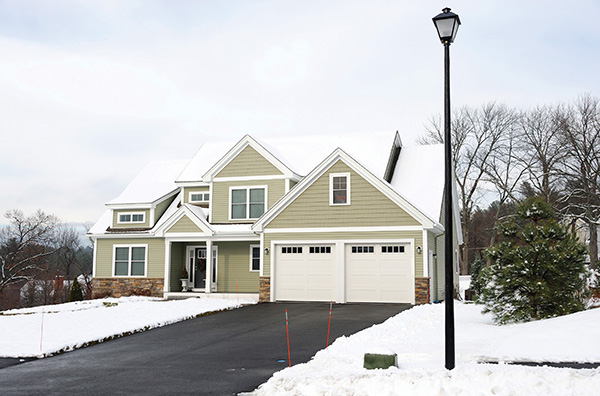
Clearing the Way
November 4, 2020 | By Mike Miller
Understanding the options for snowmelt systems and the best application for your clients.

(Adobe Stock)
The demand for snow and ice melting (SIM) systems continues to increase as property owners realize the convenience and safety benefits the systems provide. These hydronic systems are designed to remove snow and ice by circulating a heat transfer fluid through tubing installed in or below an outdoor surface (concrete, asphalt, or interlocking stone). Increasingly snowmelt applications are offering added peace of mind for property owners of every kind, especially commercial businesses, multi-unit residential properties and institutional buildings where they can reduce liability issues and improve access to facilities, which is even more relevant with our aging population where mobility issues can be a challenge.
Traditional snow-clearing methods (shovels, snowblowers and ploughs) over a long winter can result in unpredictable maintenance costs for property owners and the use of chemicals can damage hard surfaces. Hydronic SIM systems will pay for themselves over time, and setting them up correctly will only enhance that payback.
Controls
Designing an effective snow-melting system takes into consideration several factors, including Btu/sq.ft./hour load requirements, snowfall rates, snow density, snow temperature, outside temperature, wind speed, tubing size and tubing spacing. All these factors help a professional system designer and installer create a system that will be the most efficient and effective for the project.
When it comes to controlling the system, there are several options to choose from, including automatic, semi-automatic and manual controls.
A fully automatic system uses a sensor placed in the ground to detect when snowfall begins. The sensor sends a signal to the heat source to activate the warm liquid flow through the radiant tubing. Once the snowfall stops and the sensor is dry and clear of snow and ice, it sends a signal to stop the water flow and shut down the system. This energy-efficient method is typically the most economical, as it runs only when needed.
The location of the snow/ice detector is very critical. It should be located in an area where it would be most likely to detect snow accumulation. The detector usually adds to the initial component cost, but it helps run the system economically. Compared to a manual or semi-automatic system, the automatic sensor addition often pays for itself within months.
A semi-automatic control requires a manual intervention to start the system, but also includes a timer that will operate for a pre-set amount of time and then shut the system off. Setting the right amount of time is the key and often hard to predict.
A manual control is simply that—the system turns on and off with the flip of a switch. While this is the most cost-effective option to install, it generally costs more to operate, as the human interface requirement typically doesn’t align with that of perfect timing to start or stop a system. Operationally, it could quickly become very expensive to operate if disabled too late or worse yet, forgotten about until the fuel bill is in the mail.
If turned off too early, it could pose a safety threat as any water from the just melted snow could reform into ice if not completely removed. When enabled too late, the slab’s pick-up time will increase, as will the running time. This system definitely requires an attentive user.
Another option for controlling a snow-melt surface is to idle the system at a pre-set temperature (typically 22°F to 28°F) to ensure it can ramp up quickly in the event of snowfall. This option is often useful in critical areas that must remain snow- and ice-free, such as walkways or entryways to buildings to keep them safe. The idle option can be used with either automatic or semi-automatic controls.
Any of these systems should run off a slab sensor embedded in the slab for accurate surface temperature control. Setting the right surface temperature for a melting event may change how the system performs.
For example, higher melting slab surface temperatures help clear off snow from a surface more quickly, but they are more expensive to operate as the temperature difference of slab surface temperature compared to ambient outdoor temperature is greater and therefore the load is greater.
Lower melting surface temperatures clear off snow at a slower rate, but the load of the system is decreased as the temperature difference between slab surface and outdoor air is lower. Melting surface temperatures that I personally use for snow melting systems are typically 36F residentially and 38F commercially.
You can also operate zoned snow melting systems with multiple automatic snow/ice detectors. Zoned snow melting systems accommodate higher priority and lower priority zones, as well as different slab surfaces.
Snow melting systems should never run without a system controller that was developed and designed specifically for that purpose. The reason for this is that most controls today come with very intense algorithms to make snow melting as efficient as possible.
The system should have outdoor temperature guided capability that can override the system from entering snow melting mode if it is too warm outside and mother nature could melt the snow for free, or if the outdoor conditions are so extreme that a given heat source would not have enough capacity to get the job done.
Depending on surface covering, some snow melting systems may need to control the rate of slab surface temperature rise to avoid damage to a slab caused by tensile stresses from a cold start.
Applications
Just like a radiant floor heating application, these systems circulate a warm water/glycol mixture through tubing. Embedded hydronic SIM systems can be used in any exterior area, including stairs, sidewalks, driveways, parking lots, parking ramps, loading docks, building entrances, wheelchair access ramps, and even helipads on building tops. Almost any area that accumulates snow or ice can benefit from a snow-melting system.
Higher-end residential properties most often suit fully-automatic systems or a combination of fully-automatic and semi-automatic. The combination system is often used where there is a higher traffic area or zone, such as driveway and sidewalk that uses an automatic snow/ice detector, and a separate zone for a patio or deck, or around pools and hot tubs, that would only run if in use. In this case, there would be two zones, one with an automatic snow/ice detector and one with just a slab sensor and some sort of push-button device.
On the high-end residential and commercial side, properties often have multiples of fully automatic and possibly semi-automatic snow melting zones. Fully-automatic zones may include parking lots, driveways, sidewalks and different exposures or surfaces. Lower traffic areas, such as patios or loading ramps, call for a semi-automatic system.
Challenges
The main challenges I hear about snowmelt systems are operating costs and the length of time it takes to clear the surface. When digging into higher operating costs, I often find that slab melt temperature setpoints are too high. The user needs to understand that the greater the surface temperature is set to, the greater the energy consumption. I typically recommend keeping a snowmelt surface temperature just above freezing (36F is a setpoint I normally run with).
Regarding the amount of time it takes for the snow to melt. With lower melt setpoints, it will take longer to melt the slab. The question the client needs to ask is what does he/she have more of, money or patience? The differences between time versus costs need to be explained at the outset.
Idling is another discussion you would want to have with the client. If you are idling a slab, it will reduce the melting time once the snow does land, but it will also cost more to idle a slab while waiting for snow accumulation that may or may not come.
I personally do not recommend idling of snowmelt slabs for residential applications. It makes more sense in commercial applications..
If idling of a snowmelt slab is what the client wants, the same principle mentioned above applies. The lower the idling setpoint, the more cost effective it will end up being. I often recommend something in the neighbourhood of 29F for an idling setpoint.
Before starting a SIM system design it is very important to evaluate the customer’s needs and expectations.
Snow melting can be a science on its own and there are always other features, functions and benefits to evaluate.
CSA B214-16 Installation Code for Hydronic Heating Systems, chapter 17, includes snow and ice melting systems as stand-alone systems and covers several topics including: controls, freeze protection, tubing placement, spacing of tube fasteners, loop lengths, and insulation.
Whatever the application, the manufacturers and suppliers specializing in this field can assist in working through the options. <>

 Mike Miller is director of sales, commercial building services, Canada with Taco Inc. He can be reached at hydronicsmike@tacocomfort.com.
Mike Miller is director of sales, commercial building services, Canada with Taco Inc. He can be reached at hydronicsmike@tacocomfort.com.


